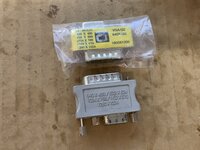jessenator
Well-known member
So, in reference to an earlier post, I'm wondering what options there are. Here's what I said in detail there:
Long and short, the flat panel I have will output the desired resolution and refresh, and my slower 8-XJ card will output, but I'm looking for the faster, native graphics chipset to output to my Sony multi-sync display.
So far, I have a fixed-resolution NEC adapter (832x624), a ViewSonic DIP adapter (which strangely doesn't support 1152x870 on the 650...the piece of paper in the plastic shows only 'Centris 650' so it predates the Quadra proper), and just acquired one of the gray NEC """""multisync""""" adapters, which really just supports 3 resolutions, the highest being 1024x768 (in fact, on the side opposite the NEC logo, it shows those three resolutions—something carefully omitted from the eBay listing).

I'm wondering if there's another solution out there for 1152x870 short of finding a newer-than-what-I-have, late-stage DIP adapter like this one.
I also have, what is hand-labeled to be, a Pivot monitor cable,. 3-row DB-15 on one end, and 2-row DA-15 on the other. I don't know what voodoo is happening in the cable, but it won't work at all with the built-in video. Works fine with the PrecisionColor card I have, but radius plays with radius, I guess. Incidentally, it only supports 1150x870 while using the card...
Anyway, wondering if anyone's dealt with this scenario before.
Also, for those curious, here's the NEC adapter with its plastic sheath removed:


reminiscent of a surplus ammo can from eastern Europe just completely covered in solder. I think part of me was hoping there was something to tweak to get two-page mode...
just completely covered in solder. I think part of me was hoping there was something to tweak to get two-page mode...
Long and short, the flat panel I have will output the desired resolution and refresh, and my slower 8-XJ card will output, but I'm looking for the faster, native graphics chipset to output to my Sony multi-sync display.
So far, I have a fixed-resolution NEC adapter (832x624), a ViewSonic DIP adapter (which strangely doesn't support 1152x870 on the 650...the piece of paper in the plastic shows only 'Centris 650' so it predates the Quadra proper), and just acquired one of the gray NEC """""multisync""""" adapters, which really just supports 3 resolutions, the highest being 1024x768 (in fact, on the side opposite the NEC logo, it shows those three resolutions—something carefully omitted from the eBay listing).

I'm wondering if there's another solution out there for 1152x870 short of finding a newer-than-what-I-have, late-stage DIP adapter like this one.
I also have, what is hand-labeled to be, a Pivot monitor cable,. 3-row DB-15 on one end, and 2-row DA-15 on the other. I don't know what voodoo is happening in the cable, but it won't work at all with the built-in video. Works fine with the PrecisionColor card I have, but radius plays with radius, I guess. Incidentally, it only supports 1150x870 while using the card...
Anyway, wondering if anyone's dealt with this scenario before.
Also, for those curious, here's the NEC adapter with its plastic sheath removed:


reminiscent of a surplus ammo can from eastern Europe


